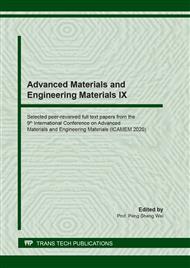[1]
M. Carmo, D.L. Fritz, J. Mergel, D. Stolten, A comprehensive review on PEM water electrolysis, Int. J. Hydrogen. Energ. 38 (2013) 4901-34.
DOI: 10.1016/j.ijhydene.2013.01.151
Google Scholar
[2]
M. Schalenbach, M. Carmo, D.L. Fritz, J. Mergel, D. Stolten, Pressurized PEM water electrolysis: Efficiency and gas crossover, Int. J. Hydrogen. Energ. 38 (2013) 14921-33.
DOI: 10.1016/j.ijhydene.2013.09.013
Google Scholar
[3]
C.C.L. McCrory, S. Jung, J.C. Peters, T.F. Jaramillo, Benchmarking Heterogeneous Electrocatalysts for the Oxygen Evolution Reaction, J. Am. Chem. Soc. 135 (2013) 16977-87.
DOI: 10.1021/ja407115p
Google Scholar
[4]
T. Reier, H.N. Nong, D. Teschner, R. Schlögl, P. Strasser, Electrocatalytic Oxygen Evolution Reaction in Acidic Environments - Reaction Mechanisms and Catalysts, Adv. Energy. Mater. 7 (2017) 1601275.
DOI: 10.1002/aenm.201601275
Google Scholar
[5]
R. Omrani, B. Shabani, Review of gas diffusion layer for proton exchange membrane-based technologies with a focus on unitised regenerative fuel cells, Int. J. Hydrogen. Energ. 44 (2019) 3834-60.
DOI: 10.1016/j.ijhydene.2018.12.120
Google Scholar
[6]
S.A. Grigoriev, P. Millet, S.A. Volobuev, V.N. Fateev, Optimization of porous current collectors for PEM water electrolysers, Int. J. Hydrogen. Energ. 34 (2009) 4968-73.
DOI: 10.1016/j.ijhydene.2008.11.056
Google Scholar
[7]
R. Shan, T. Zhang, Z. Zhang, M. Kan, Q. Zan, Y. Zhao, A novel highly active nanostructured IrO2/Ti anode for water oxidation, Int. J. Hydrogen. Energ. 40 (2015) 14279-83.
DOI: 10.1016/j.ijhydene.2015.04.071
Google Scholar
[8]
L. Wu, X. Liu, J. Hu, Electrodeposited SiO2 film: a promising interlayer of a highly active Ti electrode for the oxygen evolution reaction, J. Mater. Chem. A. 4 (2016) 11949-56.
DOI: 10.1039/c6ta03931f
Google Scholar
[9]
S. Choe, B. Lee, M.K. Cho, H. Kim, D. Henkensmeier, S.J. Yoo, et al., Electrodeposited IrO2 /Ti electrodes as durable and cost-effective anodes in high-temperature polymer-membrane-electrolyte water electrolyzers, Appl. Catal. B: Environ. 226 (2018) 289-94.
DOI: 10.1016/j.apcatb.2017.12.037
Google Scholar
[10]
B. Liu, C. Wang, Y. Chen, Surface determination and electrochemical behavior of IrO 2 -RuO 2 -SiO 2 ternary oxide coatings in oxygen evolution reaction application, Electrochim. Acta. 264 (2018) 350-7.
DOI: 10.1016/j.electacta.2018.01.141
Google Scholar
[11]
W. Xu, Z. Lu, X. Sun, L. Jiang, X. Duan, Superwetting Electrodes for Gas-Involving Electrocatalysis, Accounts Chem. Res. 51 (2018) 1590-8.
DOI: 10.1021/acs.accounts.8b00070
Google Scholar
[12]
M. Jiang, H. Wang, Y. Li, H. Zhang, G. Zhang, Z. Lu, et al., Superaerophobic RuO2 -Based Nanostructured Electrode for High-Performance Chlorine Evolution Reaction, Small. 13 (2017) 1602240.
DOI: 10.1002/smll.201602240
Google Scholar
[13]
P. Liu, C. Hsu, M. Chuang, Hemin-mediated construction of iridium oxide with superior stability for the oxygen evolution reaction, J. Mater. Chem. A. 5 (2017) 2959-71.
DOI: 10.1039/c6ta10097j
Google Scholar
[14]
G.C. Da Silva, N. Perini, E.A. Ticianelli, Effect of temperature on the activities and stabilities of hydrothermally prepared IrOx nanocatalyst layers for the oxygen evolution reaction, Appl. Catal. B: Environ. 218 (2017) 287-97.
DOI: 10.1016/j.apcatb.2017.06.044
Google Scholar
[15]
S. Cherevko, T. Reier, A.R. Zeradjanin, Z. Pawolek, P. Strasser, K.J.J. Mayrhofer, Stability of nanostructured iridium oxide electrocatalysts during oxygen evolution reaction in acidic environment, Electrochem. Commun. 48 (2014) 81-5.
DOI: 10.1016/j.elecom.2014.08.027
Google Scholar
[16]
J. Lim, D. Park, S.S. Jeon, C. Roh, J. Choi, D. Yoon, et al., Ultrathin IrO2 Nanoneedles for Electrochemical Water Oxidation, Adv. Funct. Mater. 28 (2018) 1704796.
DOI: 10.1002/adfm.201704796
Google Scholar
[17]
W. Sun, Z. Wang, W.Q. Zaman, Z. Zhou, L. Cao, X. Gong, et al., Effect of lattice strain on the electro-catalytic activity of IrO2 for water splitting, Chem. Commun. 54 (2018) 996-9.
DOI: 10.1039/c7cc09580e
Google Scholar
[18]
L.C. Seitz, C.F. Dickens, K. Nishio, Y. Hikita, J. Montoya, A. Doyle, et al., A highly active and stable IrOx/SrIrO3 catalyst for the oxygen evolution reaction, Science. 353 (2016) 1011.
DOI: 10.1126/science.aaf5050
Google Scholar
[19]
G. Li, S. Li, M. Xiao, J. Ge, C. Liu, W. Xing, Nanoporous IrO2 catalyst with enhanced activity and durability for water oxidation owing to its micro/mesoporous structure, Nanoscale. 9 (2017) 9291-8.
DOI: 10.1039/c7nr02899g
Google Scholar
[20]
D.F. Abbott, D. Lebedev, K. Waltar, M. Povia, M. Nachtegaal, E. Fabbri, et al., Iridium Oxide for the Oxygen Evolution Reaction: Correlation between Particle Size, Morphology, and the Surface Hydroxo Layer from Operando XAS, Chem. Mater. 28 (2016) 6591-604.
DOI: 10.1021/acs.chemmater.6b02625
Google Scholar
[21]
Y. Matsumoto, New Types of Anodes for the Oxygen Evolution Reaction in Acidic Solution, J. Electrochem. Soc. 133 (1986) 2257.
DOI: 10.1149/1.2108389
Google Scholar
[22]
H.B. Xu, Y.H. Lu, C.H. Li, J.Z. Hu, A novel IrO2 electrode with iridium–titanium oxide interlayers from a mixture of TiN nanoparticle and H2IrCl6 solution, J. Appl. Electrochem. 40 (2010) 719-27.
DOI: 10.1007/s10800-009-0049-2
Google Scholar
[23]
J. Krýsa, L. Kule, R. Mráz, I. Roušar, Effect of coating thickness and surface treatment of titanium on the properties of IrO2 Ta2O5 anodes, J. Appl. Electrochem. 26 (1996) 999-1005.
DOI: 10.1007/bf00242194
Google Scholar


